Numerical Simulation of Impact Rockburst of Elliptical Caverns with Different Axial Ratios
Abstract
:1. Introduction
2. Y-Geo Program Method
3. Simulations of Impact Rockburst in Elliptical Cavern
3.1. Determination of Numerical Simulation Parameters
3.2. Model Establishment
3.3. Simulation Results
3.3.1. Loading Stress Path
3.3.2. Simulation Process
4. Results and Discussion
4.1. Failure Mode
4.2. Maximum Stress during Experiment
4.3. Maximum Speed of Experimental Process
4.4. Stress Nephogram
4.5. Fractal Characteristics of Crack Images
5. Conclusions
- The numerical simulation process of impact rockburst with different axis ratios displayed a quiet period, a slab-cracking period, and a rockburst period. The failure modes of the samples primarily included V-shaped blasting pits, diagonal shear cracks, horizontal tension cracks, and vertical tension cracks, which were the same as laboratory failure modes.
- With the increase in an axis ratio, maximum ejection velocity and vertical maximum stress demonstrated an increasing trend. These values were higher for the samples whose disturbance direction was perpendicular to the short axis of the ellipse than for the samples whose disturbance direction was parallel to the short axis of the ellipse.
- Numerical simulation tests confirm that during the loading process, the left and right sides of the elliptical cavity were under a compressive stress, while the upper and lower sides of the cavity experienced tensile stress. The compressive stress value was significantly larger than the tensile stress. With the increase in axis ratio, the pressure area of the samples whose disturbance direction was parallel to the short axis of the ellipse decreased, while the pressure area of the sample whose disturbance direction was perpendicular to the short axis of the ellipse increased and the pressure area was larger.
- With the loading of disturbance, the value of the fractal dimension gradually increased, and its changed process could be divided into two stages: a sudden change and a slow change. The changing trends of the samples with different axis ratios were the same in two stages. Using the fractal dimension value, it can be confirmed that the larger the axis ratio is, the more difficult it is to damage. The samples with a disturbance direction perpendicular to the short axis of the ellipse were most difficult to damage.
Author Contributions
Funding
Institutional Review Board Statement
Informed Consent Statement
Data Availability Statement
Conflicts of Interest
References
- Wu, K.; Shao, Z.; Qin, S.; Zhao, N.; Chu, Z. An Improved Nonlinear Creep Model for Rock Applied to Tunnel Displacement Prediction. Int. J. Appl. Mech. 2021, 13, 2150094. [Google Scholar] [CrossRef]
- Wu, K.; Shao, Z.; Sharifzadeh, M.; Chu, Z.; Qin, S. Analytical Approach to Estimating the Influence of Shotcrete Hardening Property on Tunnel Response. J. Eng. Mech. 2022, 148, 04021127. [Google Scholar] [CrossRef]
- Zhang, C.; Feng, X.-T.; Zhou, H.; Qiu, S.; Wu, W. Case Histories of Four Extremely Intense Rockbursts in Deep Tunnels. Rock Mech. Rock Eng. 2012, 45, 275–288. [Google Scholar] [CrossRef]
- Jing, L. A review of techniques, advances and outstanding issues in numerical modelling for rock mechanics and rock engineering. Int. J. Rock Mech. Min. Sci. 2003, 40, 283–353. [Google Scholar] [CrossRef]
- Rehman, H.; Naji, A.; Nam, K.; Ahmad, S.; Muhammad, K.; Yoo, H.-K. Impact of Construction Method and Ground Composition on Headrace Tunnel Stability in the Neelum–Jhelum Hydroelectric Project: A Case Study Review from Pakistan. Appl. Sci. 2021, 11, 1655. [Google Scholar] [CrossRef]
- Mitri, H. Fe modelling of mining-induced energy release and storage rates. J. S. Afr. Inst. Min. Metall. 1999, 99, 103–110. [Google Scholar]
- Bardet, J. Finite element analysis of rockburst as surface instability. Comput. Geotech. 1989, 8, 177–193. [Google Scholar] [CrossRef]
- Liu, G.; Karakus, M.; Mu, Z. Propagation and attenuation characteristics of rockburst-induced shock waves in coal-rock medium. Arab. J. Geosci. 2019, 12, 113. [Google Scholar] [CrossRef]
- Wang, Z.; Li, L. Study of Energy Release in Failure of Coal and Rock Near Fault on ANSYS. Geotech. Geol. Eng. 2019, 37, 2577–2589. [Google Scholar] [CrossRef]
- Zhu, W.; Liu, J.; Tang, C.; Zhao, X.; Brady, B. Simulation of progressive fracturing processes around underground excavations under biaxial compression. Tunn. Undergr. Space Technol. 2005, 20, 231–247. [Google Scholar] [CrossRef]
- Li, Z.-L.; He, X.-Q.; Dou, L.-M.; Song, D.-Z.; Wang, G.-F. Numerical investigation of load shedding and rockburst reduction effects of top-coal caving mining in thick coal seams. Int. J. Rock Mech. Min. Sci. 2018, 110, 266–278. [Google Scholar] [CrossRef]
- Qi, Q.; Chen, S.; Wang, H.; Mao, D.; Wang, Y. Study on the relations among coal bump, rockburst and mining tremor with numerical simulation. Chin. J. Rock Mech. Eng. 2003, 22, 1852–1858. (In Chinese) [Google Scholar]
- Feng, X.; Zhang, Q.; Ali, M. 3D modelling of the strength effect of backfill-rocks on controlling rockburst risk: A case study. Arab. J. Geosci. 2020, 13, 1–16. [Google Scholar] [CrossRef]
- Hatzor, Y.; He, B.-G.; Feng, X.-T. Scaling rockburst hazard using the DDA and GSI methods. Tunn. Undergr. Space Technol. 2017, 70, 343–362. [Google Scholar] [CrossRef]
- Sun, J.-S.; Zhu, Q.-H.; Lu, W.-B. Numerical Simulation of Rock Burst in Circular Tunnels Under Unloading Conditions. J. China Univ. Min. Technol. 2007, 17, 552–556. [Google Scholar] [CrossRef]
- Wu, S.; Zhou, Y.; Gao, B. Study of unloading tests of rock burst and PFC3D numerical simulation. Chin. J. Rock Mech. Eng. 2010, 29, 4082–4088. (In Chinese) [Google Scholar]
- Hu, L.; Ma, K.; Liang, X.; Tang, C.; Wang, Z.; Yan, L. Experimental and numerical study on rockburst triggered by tangential weak cyclic dynamic disturbance under true triaxial conditions. Tunn. Undergr. Space Technol. 2018, 81, 602–618. [Google Scholar] [CrossRef]
- He, M.; Ren, F.; Cheng, C. Mechanism of Strain Burst by Laboratory and Numerical Analysis. Shock. Vib. 2018, 2018, 1–15. [Google Scholar] [CrossRef] [Green Version]
- He, M.; Ren, F.; Cheng, C. Experimental and numerical analyses on the effect of stiffness on bedded sandstone strain burst with varying dip angle. Bull. Int. Assoc. Eng. Geol. 2019, 78, 3593–3610. [Google Scholar] [CrossRef]
- Munjiza, A.; Bangash, T.; John, N.W.M. The combined finite-discrete element method for structural failure and collapse. Eng. Fract. Mech. 2004, 71, 469–483. [Google Scholar] [CrossRef]
- Cai, M. Fracture Initiation and Propagation in a Brazilian Disc with a Plane Interface: A Numerical Study. Rock Mech. Rock Eng. 2013, 46, 289–302. [Google Scholar] [CrossRef]
- Hamdi, P.; Stead, D.; Elmo, D. Damage characterization during laboratory strength testing: A 3D-finite-discrete element approach. Comput. Geotech. 2014, 60, 33–46. [Google Scholar] [CrossRef]
- Mahabadi, O.; Lisjak, A.; Munjiza, A.; Grasselli, G. Y-Geo: New Combined Finite-Discrete Element Numerical Code for Geomechanical Applications. Int. J. Géoméch. 2012, 12, 676–688. [Google Scholar] [CrossRef]
- Elmo, D.; Stead, D.; Eberhardt, E.; Vyazmensky, A. Applications of Finite/Discrete Element Modeling to Rock Engineering Problems. Int. J. Géoméch. 2013, 13, 565–580. [Google Scholar] [CrossRef] [Green Version]
- Lisjak, A.; Liu, Q.; Zhao, Q.; Mahabadi, O.; Grasselli, G. Numerical simulation of acoustic emission in brittle rocks by two-dimensional finite-discrete element analysis. Geophys. J. Int. 2013, 195, 423–443. [Google Scholar] [CrossRef] [Green Version]
- Lisjak, A.; Garitte, B.; Grasselli, G.; Müller, H.J.; Garitte, B. The excavation of a circular tunnel in a bedded argillaceous rock (opalinus clay): Short-term rock mass response and fdem numerical analysis. Tunn. Undergr. Space Technol. 2015, 45, 227–248. [Google Scholar] [CrossRef] [Green Version]
- Mahabadi, O.K. Investigating the Influence of Microscale Heterogeneity and Microstructure on the Failure and Mechanical Behaviour of Geomaterials; University of Toronto: Toronto, ON, Canada, 2012. [Google Scholar]
- Mahabadi, O.; Kaifosh, P.; Marschall, P.; Vietor, T. Three-dimensional FDEM numerical simulation of failure processes observed in Opalinus Clay laboratory samples. J. Rock Mech. Geotech. Eng. 2014, 6, 591–606. [Google Scholar] [CrossRef] [Green Version]
- Yu, Y.; Geng, D.-X.; Tong, L.-H.; Zhao, X.-S.; Diao, X.-H.; Huang, L.-H. Time Fractal Behavior of Microseismic Events for Different Intensities of Immediate Rock Bursts. Int. J. Géoméch. 2018, 18, 06018016. [Google Scholar] [CrossRef]

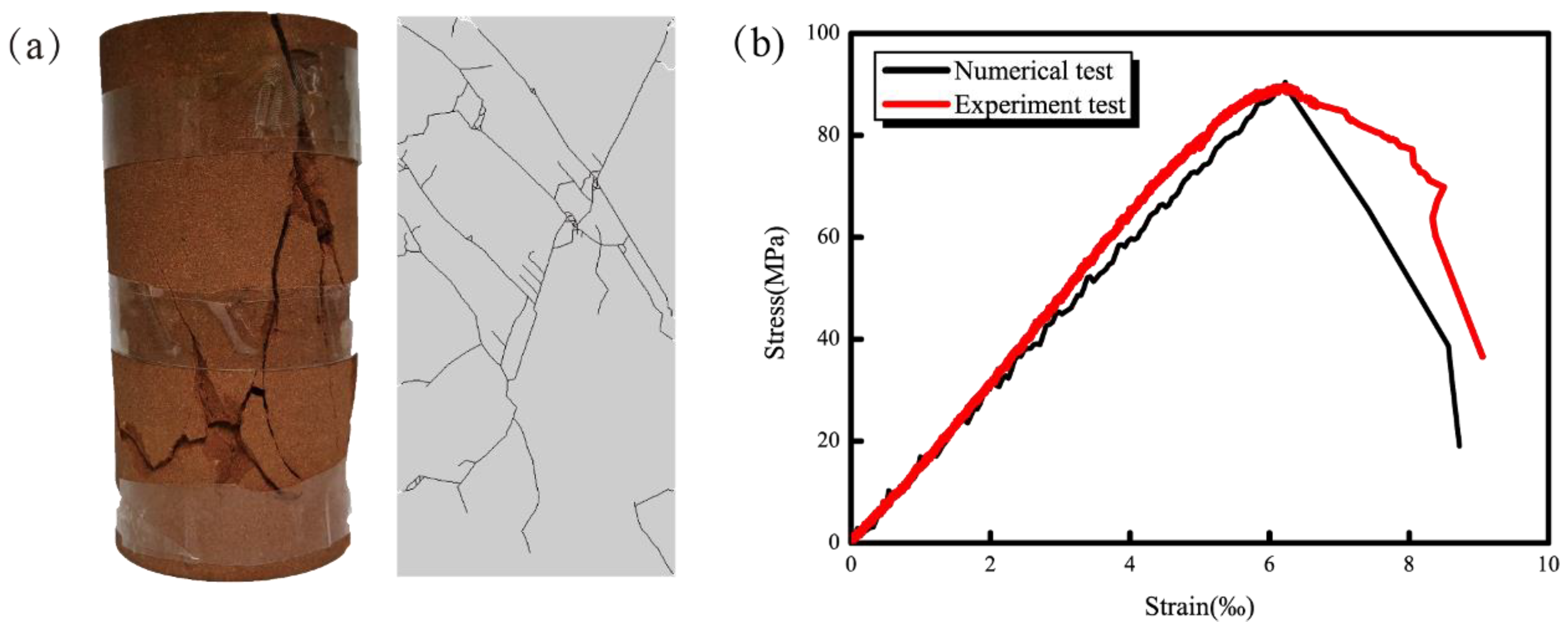

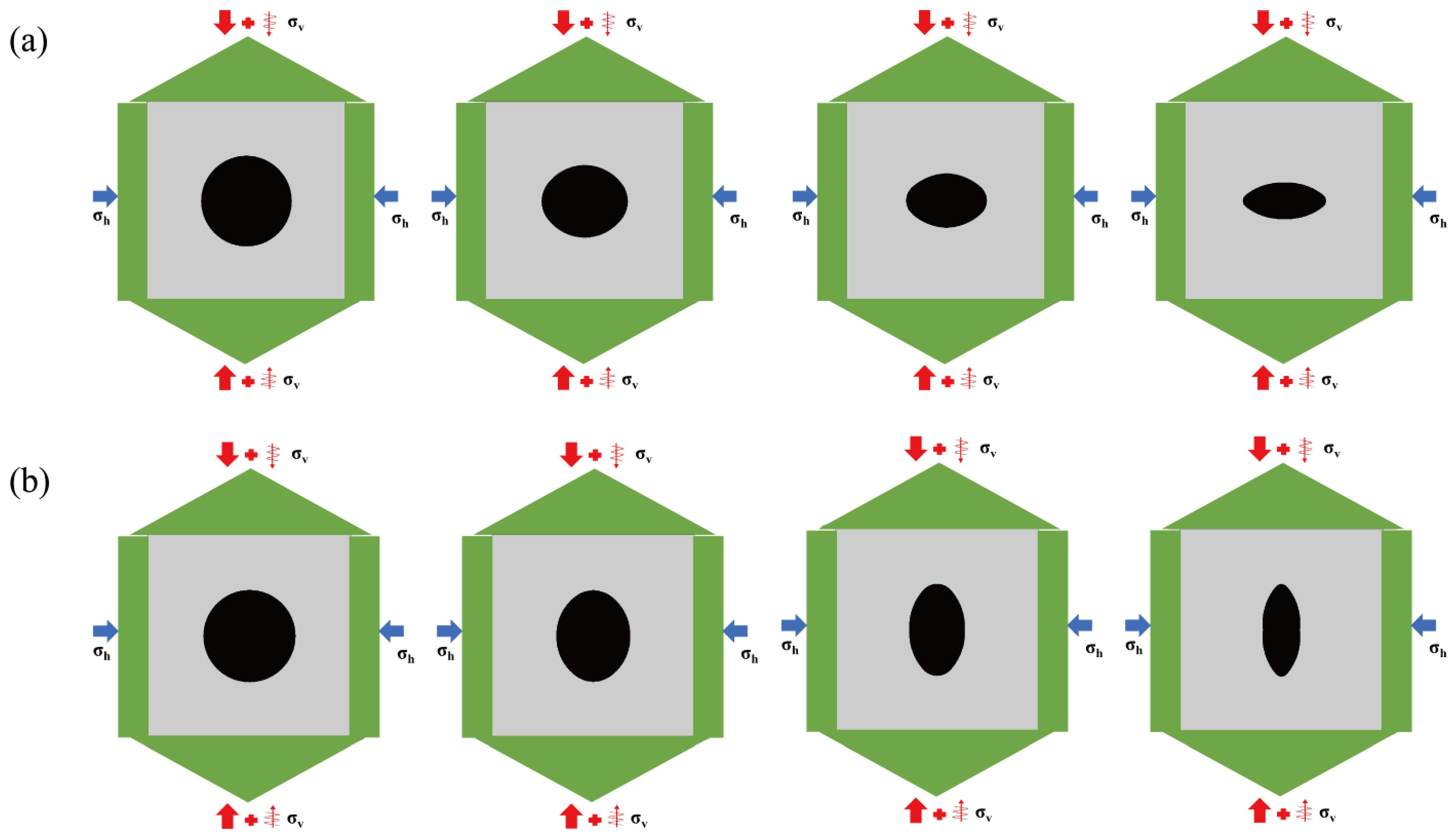
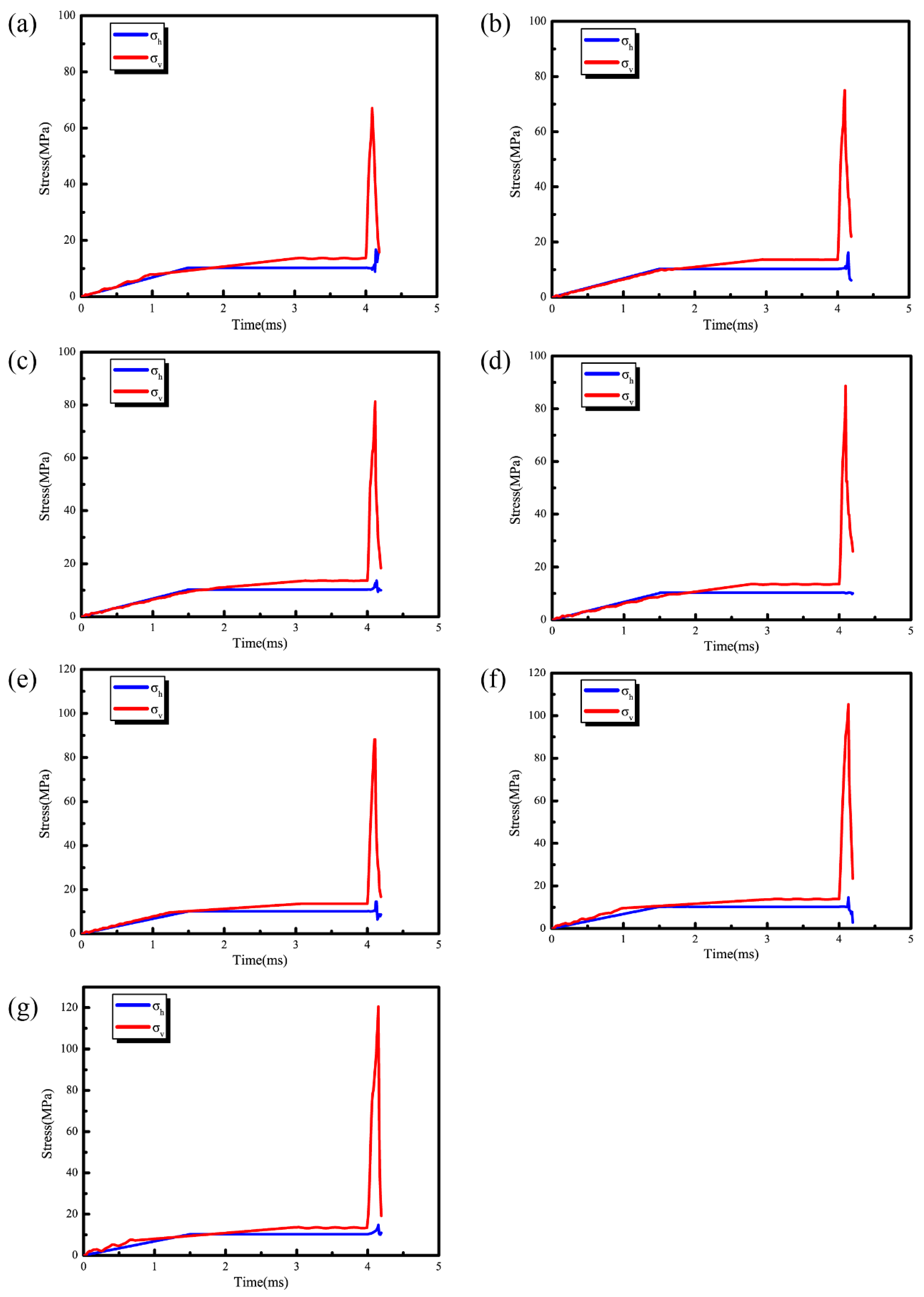
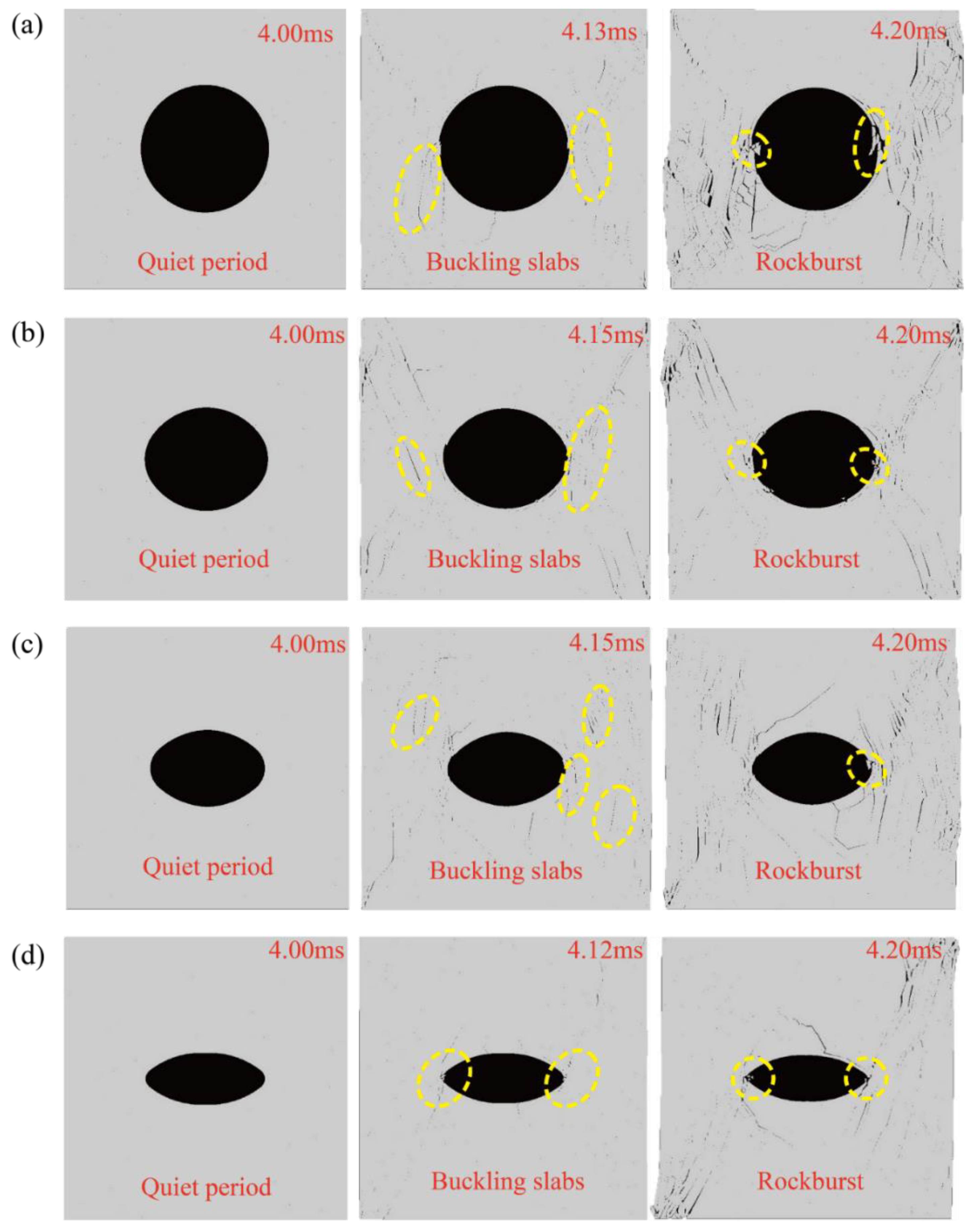

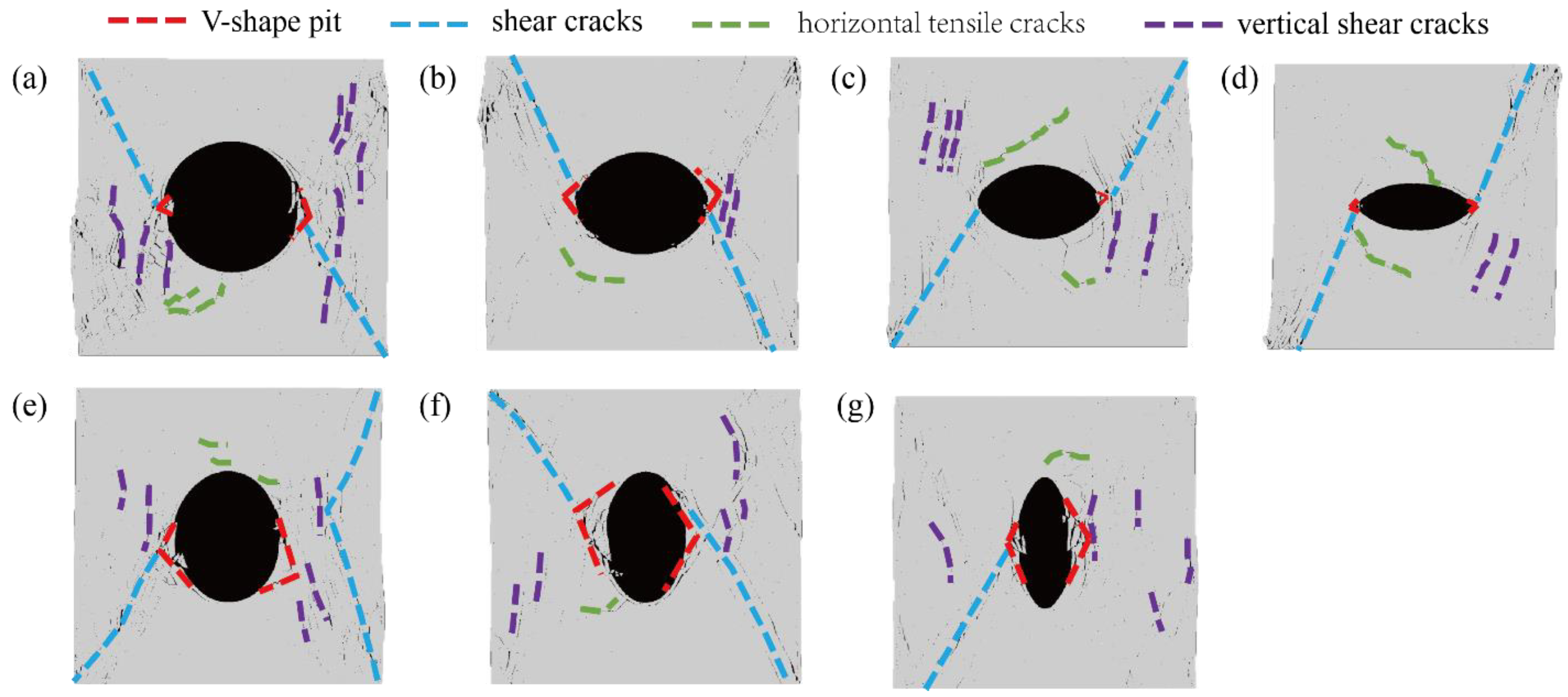

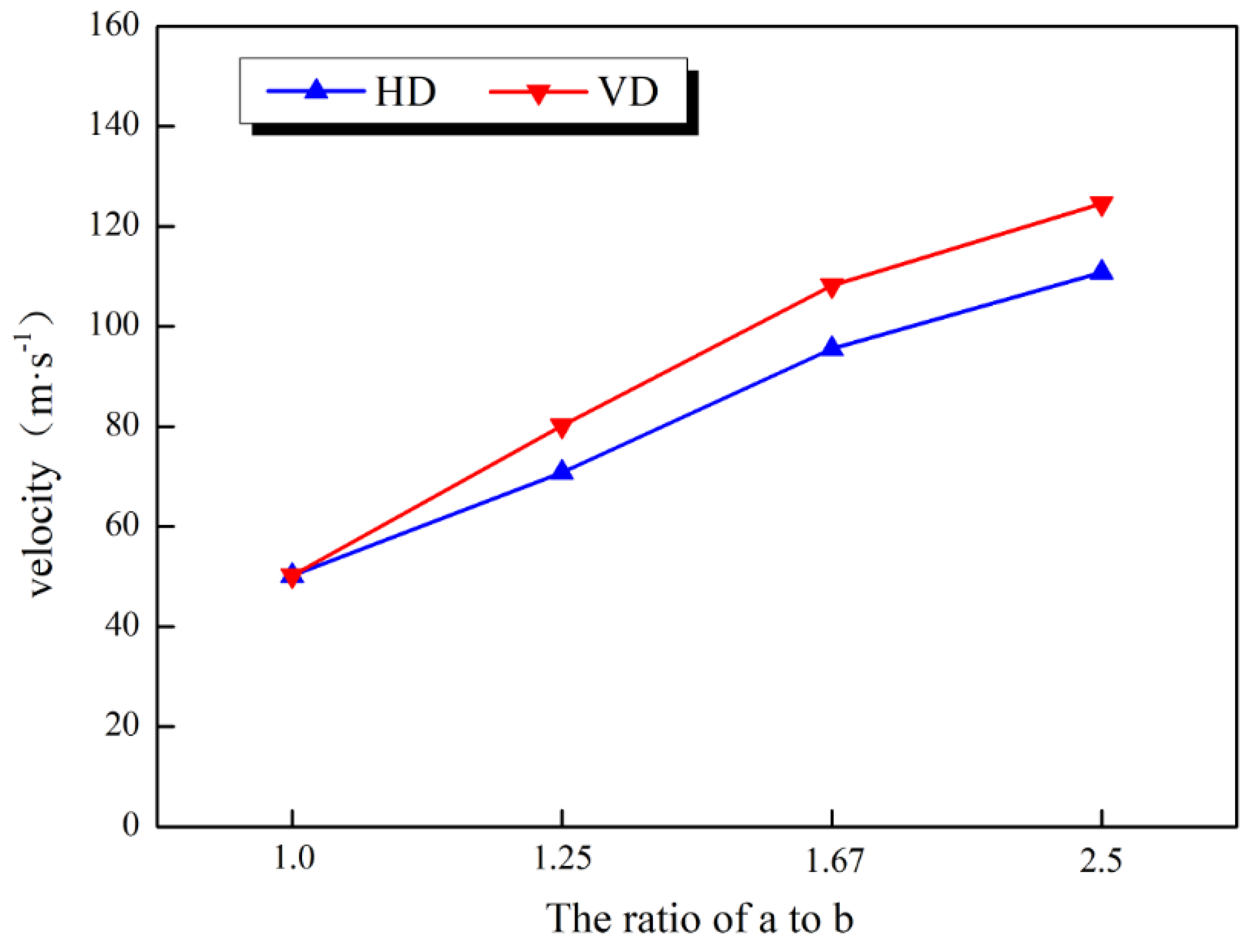
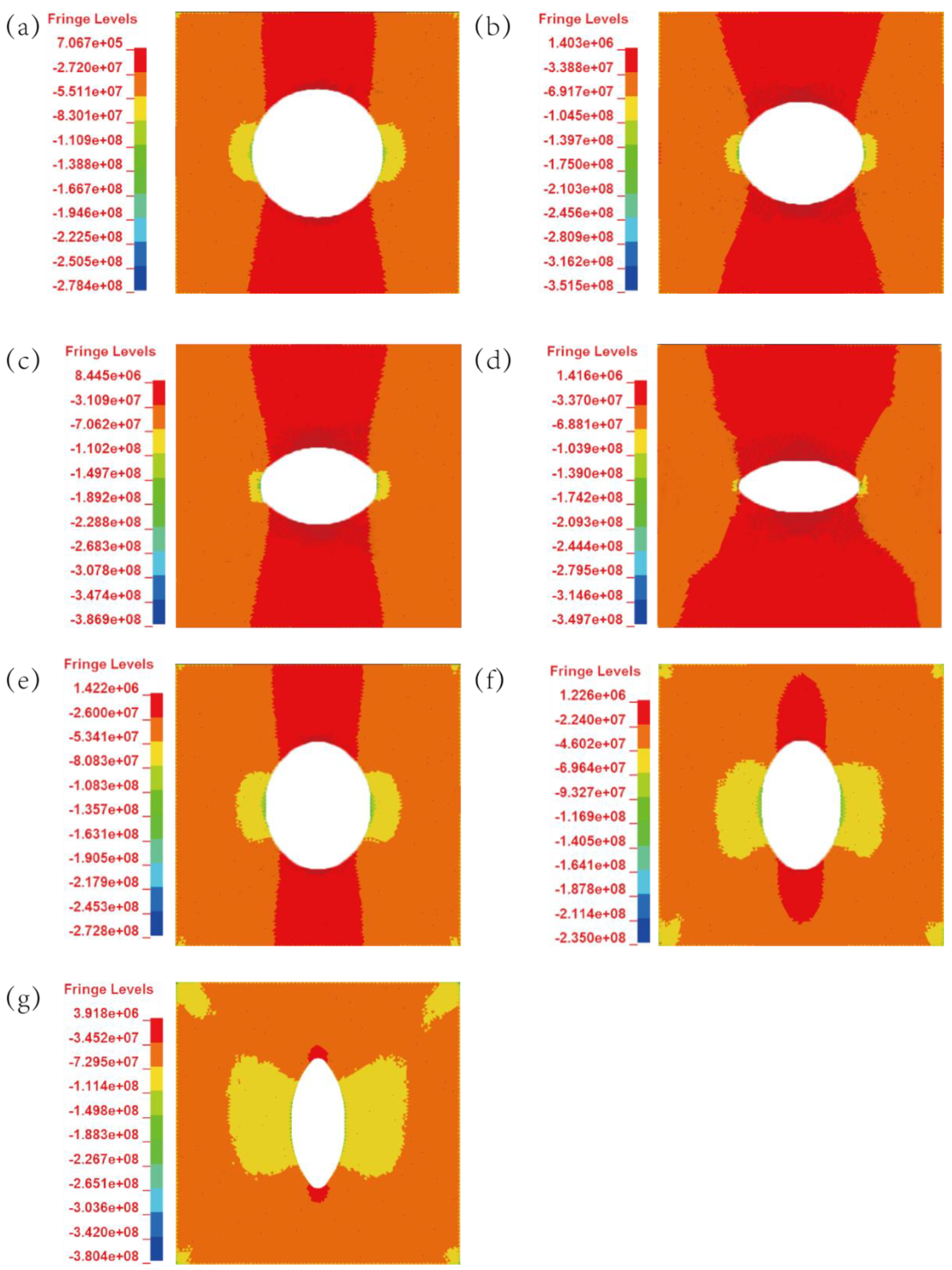
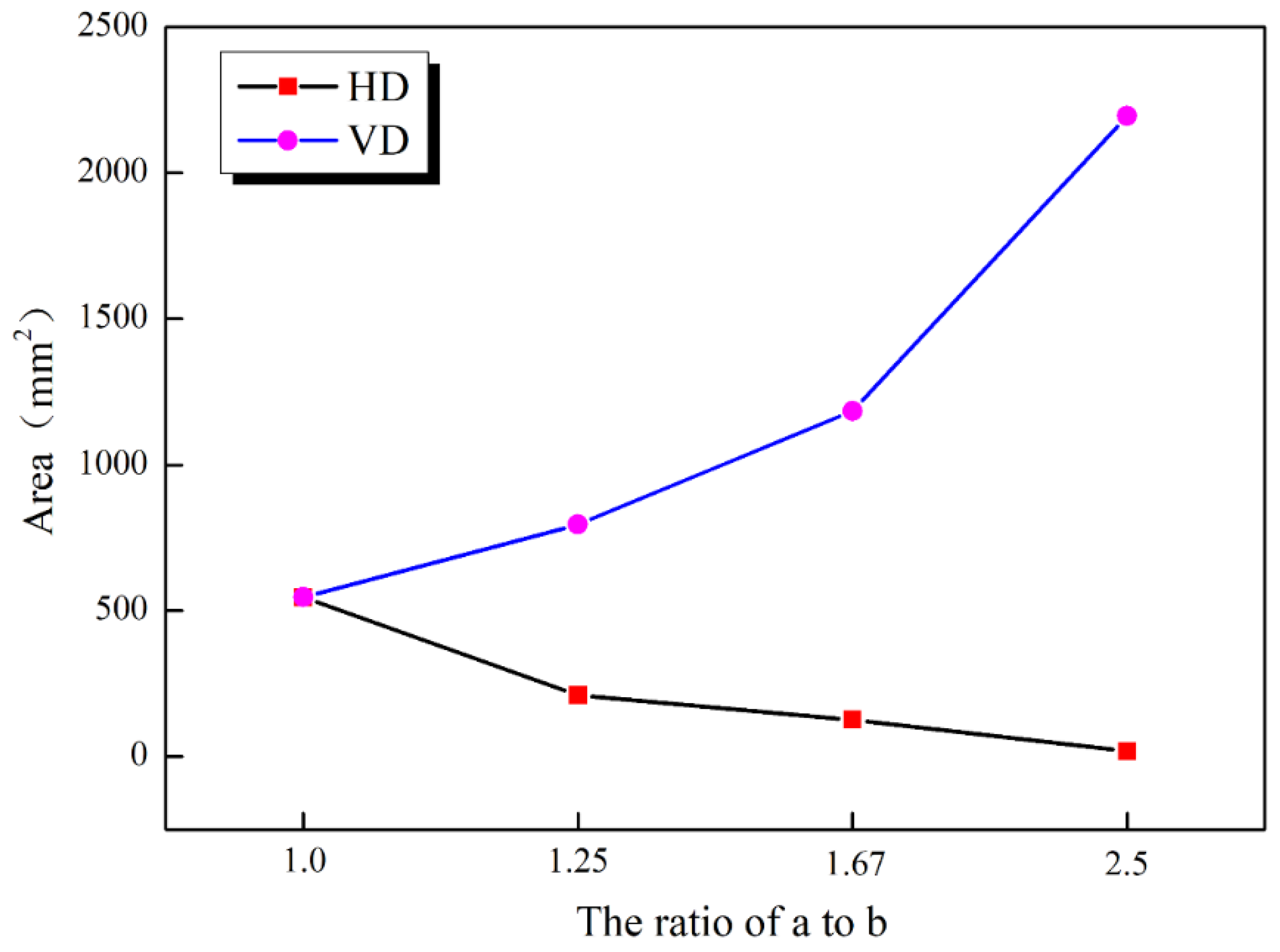
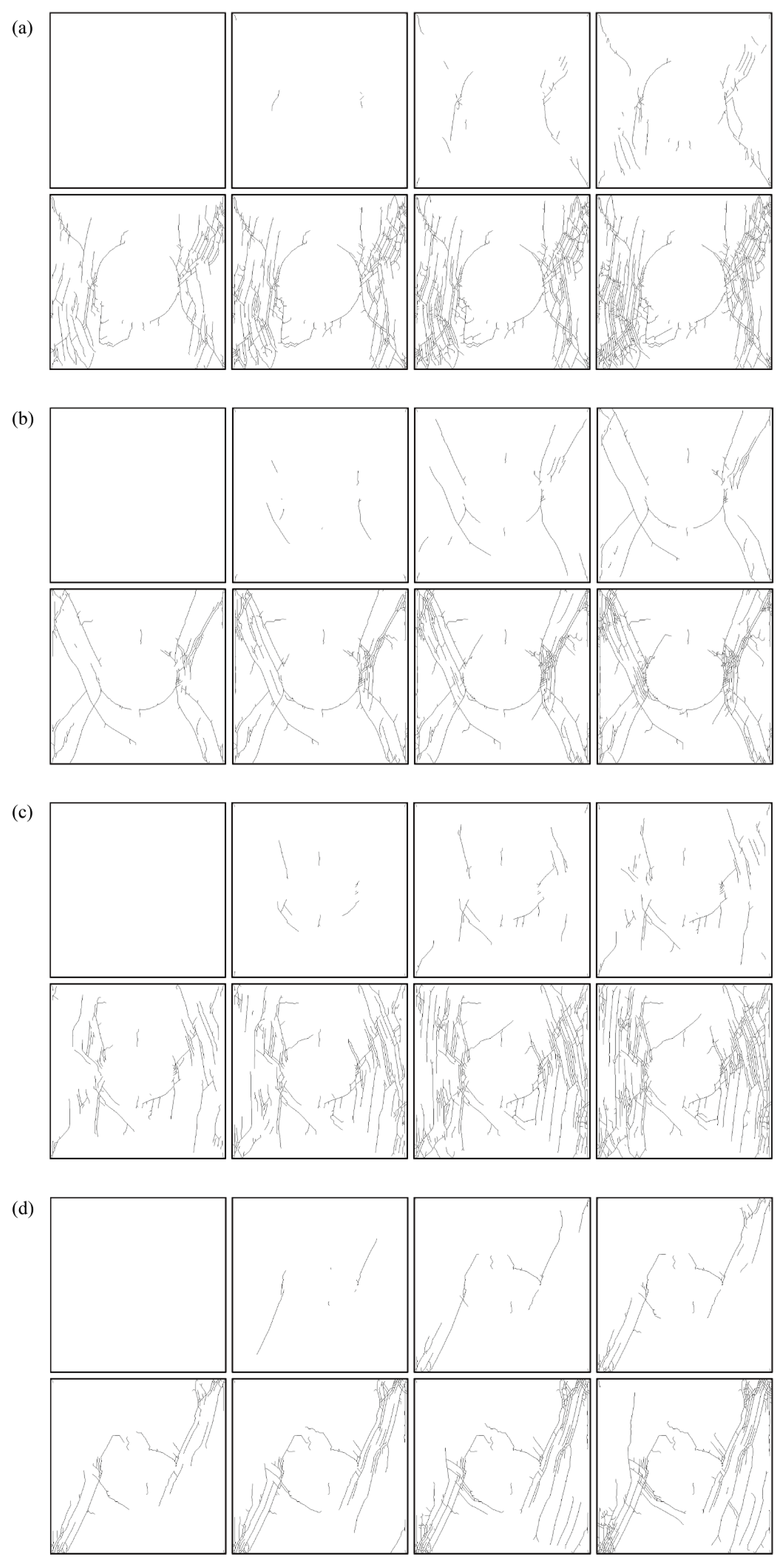
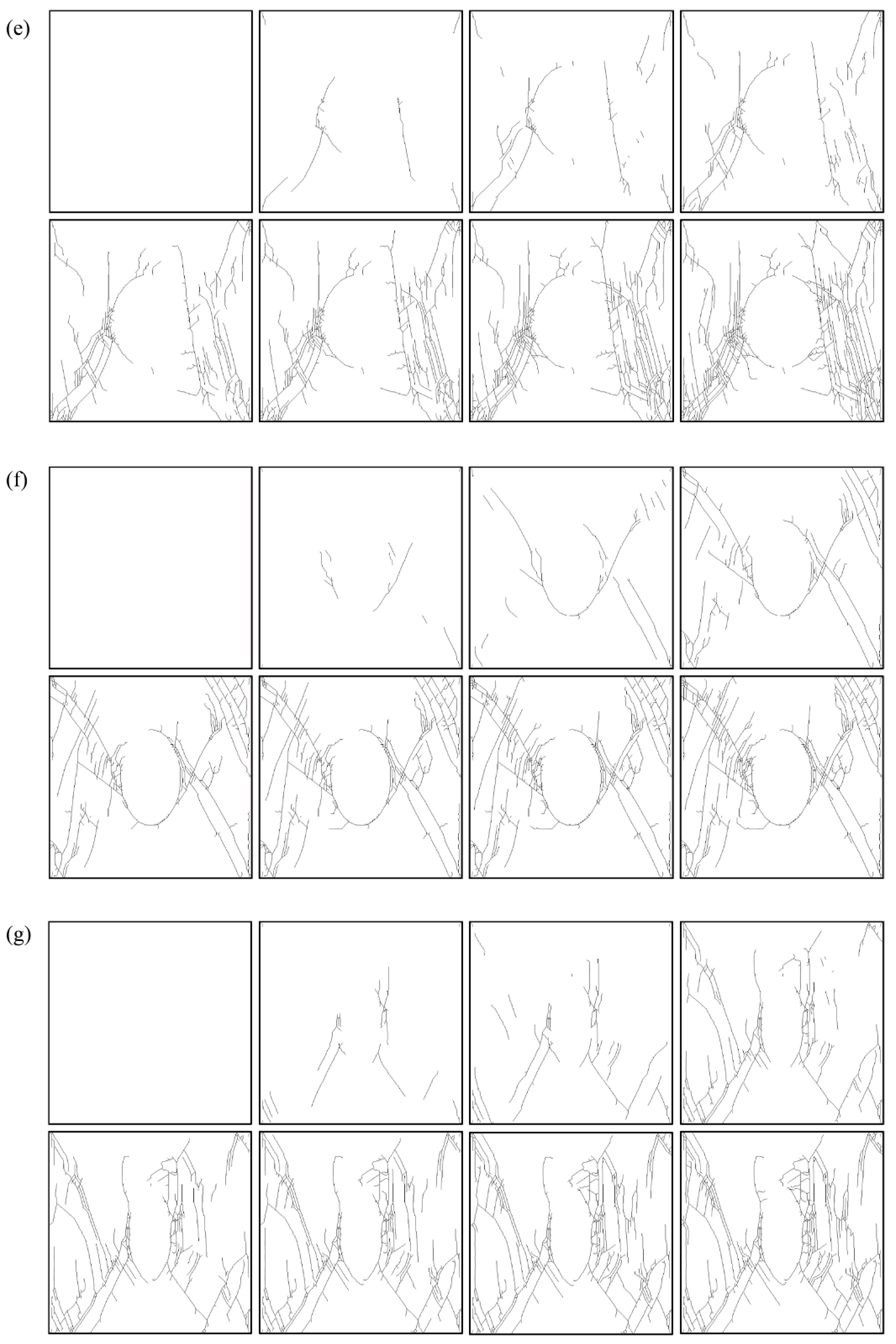
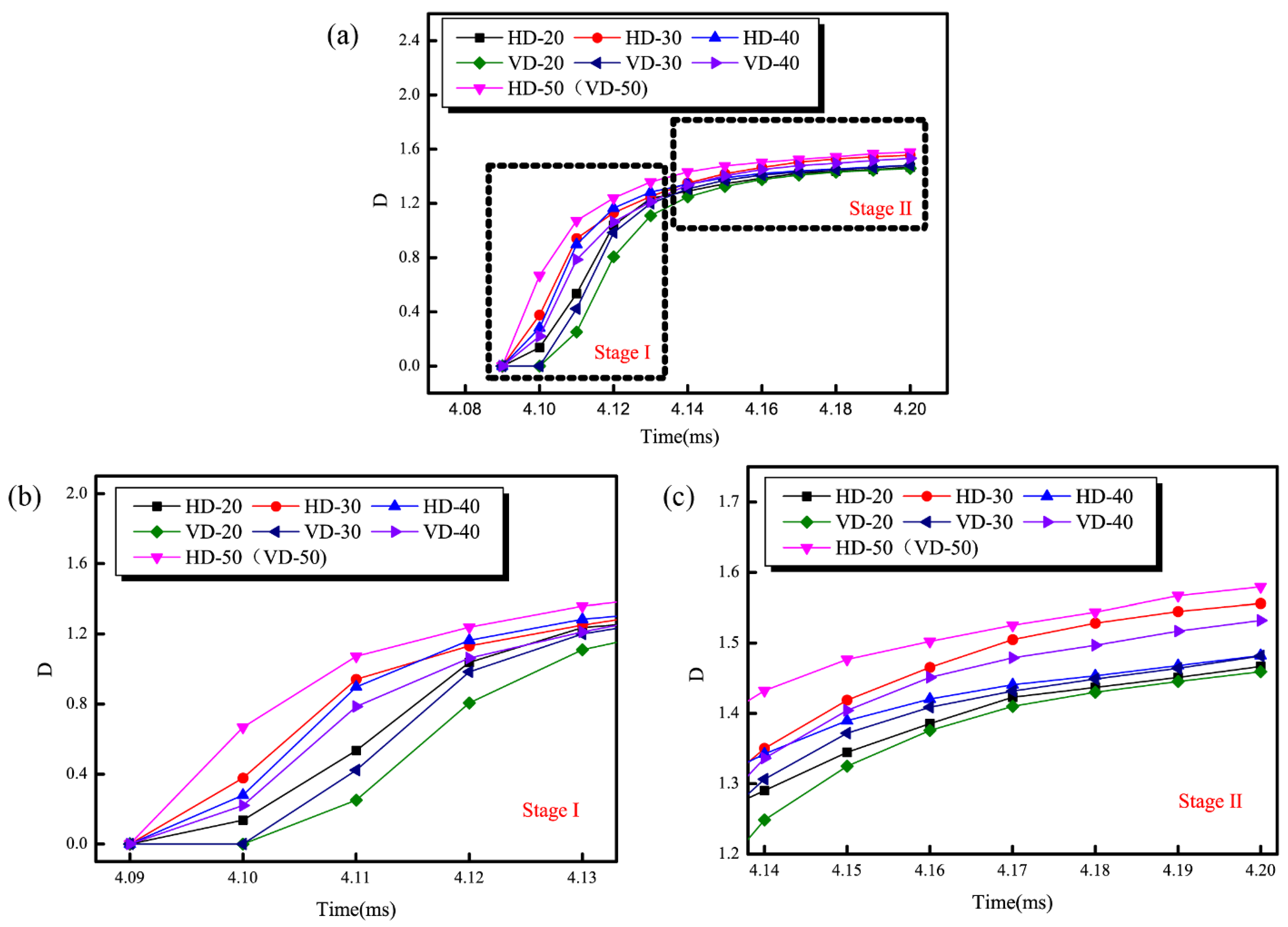
| Material Parameters | Symbol | Unit | Rock Sample | Loading Plate |
|---|---|---|---|---|
| Density | ρ | (kg/m3) | 3240 | 8000 |
| Elasticity modulus | E | (GPa) | 8.6 | 200 |
| Poisson ratio | μ | / | 0.22 | 0.3 |
| Viscous damping | ks | (g/m/s) | 1.46 × 107 | 2 × 109 |
| Tangential penalty factor | Pt | (GPa) | 9.6 | 200 |
| Normal penalty factor | Pn | (GPa) | 96 | 2000 |
| Fracture penalty factor | Pf | (GPa) | 96 | 2000 |
| Tensile strength | σt | (MPa) | 15 | 15 |
| Cohesion | c | (MPa) | 6.51 | / |
| Internal friction angle | φ | (deg) | 35 | / |
| Fracture energy | Gf | (J/m2) | 40 | 40 |
| No. | σh/MPa | σV/MPa | a/mm | b/mm | a/b |
|---|---|---|---|---|---|
| H-20 | 10.2 | 13.6 | 50 | 20 | 2.5 |
| H-30 | 10.2 | 13.6 | 50 | 30 | 1.67 |
| H-40 | 10.2 | 13.6 | 50 | 40 | 1.25 |
| H-50 (V-50) | 10.2 | 13.6 | 50 | 50 | 1 |
| V-20 | 10.2 | 13.6 | 50 | 20 | 2.5 |
| V-30 | 10.2 | 13.6 | 50 | 30 | 1.67 |
| V-40 | 10.2 | 13.6 | 50 | 40 | 1.25 |
Publisher’s Note: MDPI stays neutral with regard to jurisdictional claims in published maps and institutional affiliations. |
© 2021 by the authors. Licensee MDPI, Basel, Switzerland. This article is an open access article distributed under the terms and conditions of the Creative Commons Attribution (CC BY) license (https://creativecommons.org/licenses/by/4.0/).
Share and Cite
Wang, Y.; Li, X.; Li, J.; Xu, J. Numerical Simulation of Impact Rockburst of Elliptical Caverns with Different Axial Ratios. Sustainability 2022, 14, 241. https://doi.org/10.3390/su14010241
Wang Y, Li X, Li J, Xu J. Numerical Simulation of Impact Rockburst of Elliptical Caverns with Different Axial Ratios. Sustainability. 2022; 14(1):241. https://doi.org/10.3390/su14010241
Chicago/Turabian StyleWang, Yang, Xue Li, Jiyu Li, and Jipeng Xu. 2022. "Numerical Simulation of Impact Rockburst of Elliptical Caverns with Different Axial Ratios" Sustainability 14, no. 1: 241. https://doi.org/10.3390/su14010241







